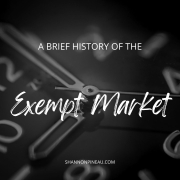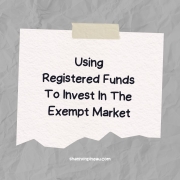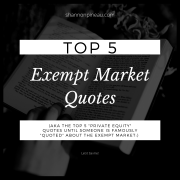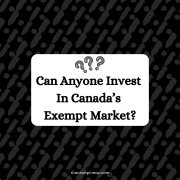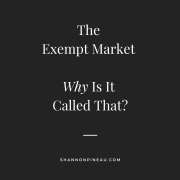The Exempt Market (also known as the private or alternative market) has been around for centuries as people have always raised private capital to fund their developments.
Prior to the 2000’s though, this market was generally only known to the very wealthy and not available to average investors.
Common Exemptions Used in the Past
At that time, companies that didn’t want to complete a full prospectus in order to raise capital used an exemption from prospectus. Some examples include:
– Raising money from only friends and family
– Having a $150,000 minimum investment amount or
– Raising capital from accredited (high net worth) investors.
A Common Exemption Used Now
In the 2000’s, this all changed with increased use of another common exemption – the Offering Memorandum.
This document is a more condensed version of a prospectus and allows average investors to enter the Exempt Market with:
– Lower minimum investment amounts
– The ability to be an eligible instead of an accredited investor
All Of This Led To The Change in Terminology
I mentioned in a previous post that using one of these “exemptions” from a prospectus to invest in the private market is how the market got its name – The Exempt Market.
In addition, the changes that took place in the market in 2009 gave rise to a new entity called the “Exempt Market Dealer” or EMD, which further cemented the name.
So, to be fair, the official name THE EXEMPT MARKET has really only been around for the last decade.
Very Little Advertising
Another reason you don’t see or read a lot of information about the Exempt Market is because it’s not well advertised.
When the private markets really gained traction in the early 2000’s, it was a completely new market to average or “eligible” investors and there were all kinds of newspaper advertisements to bring investors out to large presentations.
At that time, the high-risk nature of private investing was not well understood by most, largely because of its newness and also because there hadn’t yet been any high-profile failures. Once the recession hit though in 2008/2009, there were many failures, and this was also the time that the provincial regulators stepped in in a big way to ensure that the proper regulations were put into place to protect investors.
This included the removal of any potentially misleading statements in advertising and also complete transparency about the high-risk nature of the market.
So, while an ad from 2007 might say:
“Come on out Thursday night and find out how to earn 12% return on your investment with a short 2 year term”
An ad nowadays would say something like:
“Come on out on Thursday night and hear about an Exempt Market issuer that could potentially deliver a good rate of return but could also cause you to lose some or all of your money”
The second is definitely better and more truthful but isn’t very appealing to a mass audience.
So, what happens now is Investors go looking online for information on how to make higher returns and eventually come upon the term “Exempt Market”. Then they might think to themselves, hmmmm…I’ve never heard that term before and then come upon my blog post. From there, they might reach out to me to find out more because there has to be something that is great about private investing otherwise no one would do it. Right?
Right! There are lots of benefits – and risks too of course. I’ll tell you more about all of this as we go.
To Sum Up
The Exempt Market itself is not new but the terminology has changed and it is not well advertised. To learn more, you have to go looking and I’m very glad you found me and read my post. Thank you!
You can keep reading to learn more about private investing in Canada and I will continue by giving you “A Brief History of the Exempt Market“.
If you would like to talk further, with no obligation, please contact me today.

Shannon Pineau
Exempt Market Dealing Representative
E: spineau@sentinelgroup.ca
C: 403-872-4010



